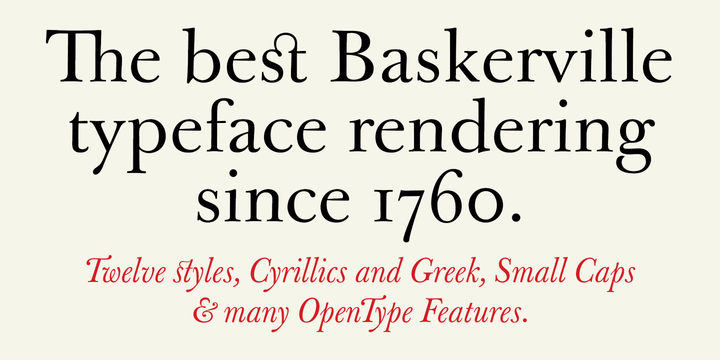

- Original baskerville typeface pro#
- Original baskerville typeface software#
- Original baskerville typeface mac#
For inherent in every fragment of any typeface is the principle, according to which it is possible, with a little bit of natural feeling, to complete the set of characters. When digitizing the typeface, we did not have at our disposal a complete alphabet – partly because Baskerville did not solve some of the characters (some of them did not even exist at the time), partly because we were loath to go to Cambridge where the greater part of the original punches is deposited. Our analytical transcription enhances rather the artistic and visual qualities of his typeface. A detailed evaluation of Baskerville’s heritage, however, remains a task for historians. Baskerville perhaps anticipated certain elements known from Bodoni and Didot, which is why nowadays everybody calls it a “transitory” phenomenon. His punchcutter John Handy was given the task to make the typeface different from the then fashionable Caslon, which was a surprise for a certain part of typophiles of the period. He proceeded along these lines also when designing his new typeface. He strove to remove everything which obstructs legibility, working without ornaments and rules, neatly, and with large margins. When composing the pages, Baskerville emphasized the importance of the blank space, just as the effect of the majestic austerity of the setting, which became an inspiration for Neo-classical typographers. These were large-size, stately prints on paper smoothed out by hot copper calender rollers. We selected as the most successful models for the digitization of this typeface its Roman and italics in the size of about today’s 14 points, which Baskerville used for the printing, among other things, of his folio Bible in 1763 and Vergil’s works in Latin in 1757. Thanks to the understanding of the librarian Petr MaÅ¡ek we were allowed to study and photograph four rare volumes from Baskerville’s printing office, dating from about 1760. Our pursuit of this paramount body typeface of the 20th century began in Nové Hrady Castle, the place where a part of the depository of old prints of the National Museum Library is kept, in the summer of 1999. Until recently the story of this typeface ended with mediocre digital versions, which did not get at the root of its inspiration.
Original baskerville typeface pro#
Baskerville Original Pro contains 12 styles and family package options. For more information visit this page.Baskerville Original Pro was published by Storm.

This typeface is available within Office applications.
Original baskerville typeface software#
License Microsoft fonts for enterprises, web developers, for hardware & software redistribution or server installations.
Original baskerville typeface mac#
All rights reserved.ġ252 Latin 1 Mac Roman Macintosh Character Set (US Roman) Typeface © 1992 Stephenson Blake (Holdings) Ltd. No type library is complete without at least one version of a Baskerville face.

This makes Baskerville look good in large sizes. Baskerville is known as the first of the transitional romans, with its greater differentiation between thick and thin strokes. The face first appeared in 1766 under the name of Isaac Moore, the foundry manager. But tell-tale differences, including the characteristic squarish curves in the capital C and G, identify it as the version first issued by the Fry type foundry, established by the Fry family after they succeeded in the chocolate business. This face is based on one developed by the renowned 18th century typographer John Baskerville.


 0 kommentar(er)
0 kommentar(er)
